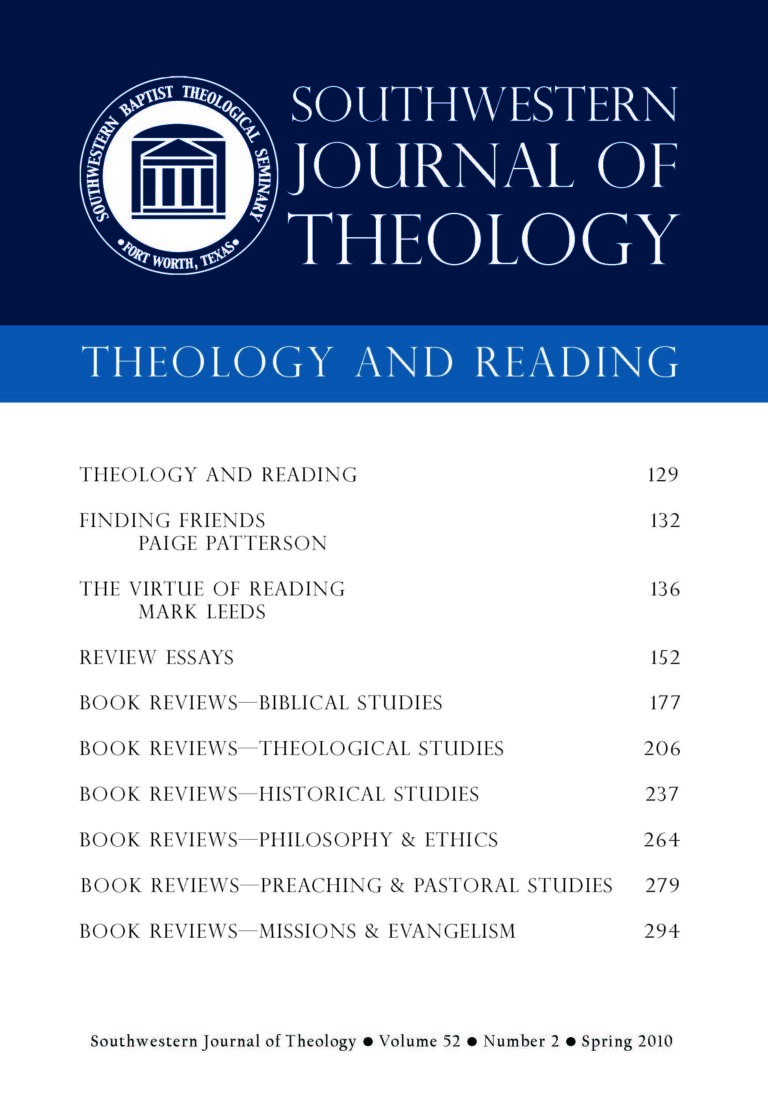
Theology and Reading
Southwestern Journal of Theology
Volume 52, No. 2 – Spring 2010
Managing Editor: Malcolm B. Yarnell III
Edited by Charles L. Quarles. Nashville: B&H Academic, 2008. 243 pages. Paperback, $24.99.
One wishes that this book had been available in early 2007. It could then counter the claims of two documentaries that archaeologists had uncovered the bones of Jesus Christ and his family members—deposited in bone boxes (ossuaries) in an East Talpiot tomb. Controversy-driven books often lack quality investigations and interpretations. Not so with Buried Hope or Risen Savior. The time taken to produce this work in no way minimizes the timeliness of this book because this story, or a similar one, will appear again in the future. When it does, an answer will be ready for those who ask if the bones that once occupied this box disprove the historicity of the Gospel accounts of an empty tomb. More significantly, this book serves as a warning to test all documentaries, movies, and books, exposes pseudo-scholarship, and presents sound guidance for correctly understanding the role of biblical archaeology, history, hermeneutics, and theology. Although written as a scholarly treatise for the general public, readers should find this book to be inspirational as well as informative as it affirms the historical credibility of the resurrection accounts of Jesus Christ.
Charles Quarles (a vice president and Professor of Religion at Louisiana College) determined the areas that required discussion. He enlisted scholars known for their skill and expertise in various areas of research, and their ability to communicate both to the scholarly community and to the general public. In the introduction, Quarles presents the background of the claims made by James Cameron and Simcha Jacobovici, the producers of the documentary The Lost Tomb of Jesus, and by Simcha Jacobovici and Charles Pellegrino in the book The Jesus Family Tomb: The Discovery, the Investigation, and the Evidence That Could Change History. Quarles then reviews the immediate debate and response of scholars, in particular that of archaeologists.
Each author wrote a chapter based upon one of these issues. Steven Ortiz (Associate Professor of Archaeology and Biblical Backgrounds at Southwestern Baptist Theological Seminary) provides a guide for correctly applying the discipline of Biblical Archaeology. He exposes misleading practices of pseudo-archaeology and explains the time tested procedures of educated and experienced archaeologists. As he does this, he applies those guidelines specifically to the hypothesis of the Talpiot Tomb revealing its flaws.
Craig A. Evans (New Testament Professor at Acadia Divinity College) explains Jewish burial practices contemporary to the time of Jesus Christ. In particular, he deals with the Jewish burial practice of ossilegium (the gathering and reburial of the bones of the deceased). He then refutes three claims of the Talpiot Tomb hypothesis, thereby supporting the historicity of the Scriptures.
Richard Bauckham (New Testament Professor at St. Mary’s College, University of St. Andrews) employs his knowledge of onomastics (the study of names) of first-century Jewish Palestine to examine the claims of the Talpiot hypothesis. The major point under consideration was the frequency of the names found on the ossuaries. He “buries” the claim that the statistical frequency of the combination of names inscribed on the ossuaries demonstrates they had to belong to Jesus Christ and his family members.
What Bauckham does from a literary, linguistic, and historical approach to expose the statistical fallacies of the Talpiot hypothesis, William A. Dembski (Research Professor in Philosophy at Southwestern Baptist Theological Seminary) and Robert J. Marks II (Distinguished Professor of Electrical and Computer Engineering at Baylor University) do mathematically. In their chapter they “crunch the numbers” and the hypothesis comes up short.
Gary Habermas (Distinguished Research Professor and Chairman of the Department of Philosophy and Theology at Liberty University) analyzes the opinion of James Tabor, one of the few scholars who advocate that this tomb is the burial chamber of Jesus Christ. Tabor has constructed a scenario that explains the whereabouts of the body of Jesus. Habermas reveals the weaknesses in Tabor’s position by first showing his selective acceptance and rejection of resurrection reports of the Gospels and Epistles in order to advance his arguments. Habermas establishes sound reasons for believing that Paul and other resurrection witnesses held firmly to a resurrection tradition, and demonstrates why Tabor and the Talpiot Hypothesis stand opposed by sound historical evidence and modern biblical scholarship.
Michael Licona (Director of Apologetics and Interfaith Evangelism at the North American Mission Board) addresses the opinion of some that the resurrection body of Jesus was not material (flesh and bones), but immaterial (spiritual only). Licona examines Paul’s primary treatment of the resurrection of Christ found in 1 Corinthians 15:42–54 and verifies that Paul held to a physical (material) resurrection. The position of an immaterial resurrection contradicts the biblical testimony. This chapter emphasizes the perilous assertions of the Talpiot Hypothesis and underscores the need for this very book.
Darrell L. Bock (Research Professor of New Testament Studies at Dallas Theological Seminary) summarizes each chapter.This summary seems unnecessary as each author clearly presented his position, but to have the “stamp of approval” of someone with the reputation and credentials of Darrell Bock should ensure all readers of the first rate scholarly research contained in this work, and above all, will answer the question contained in the title—We have a Risen Savior!
This work contains no pictures or diagrams, but the words produce the mental images needed for understanding (while keeping printing costs down). There is no bibliography, but each writer provided the necessary bibliographical information in the footnotes, and in so doing, gives the reader not only the sources of their research, but excellent sources to consult for the points under discussion. Some chapters will take longer to read and more time to digest than others. This is the case for the chapter by Dembski and Marks, but considering the claims made for the statistical probability that this is the ossuary of Jesus of Nazareth, one dare not skip this hypothesis-shattering chapter.





